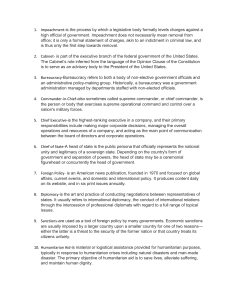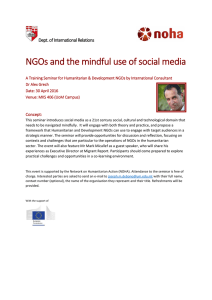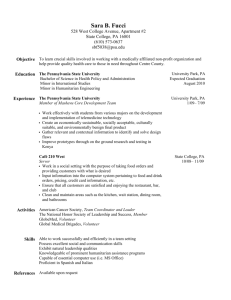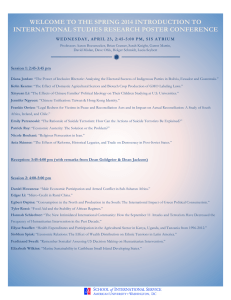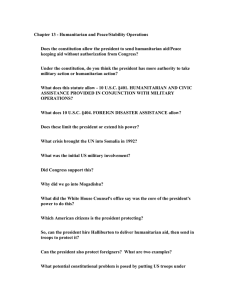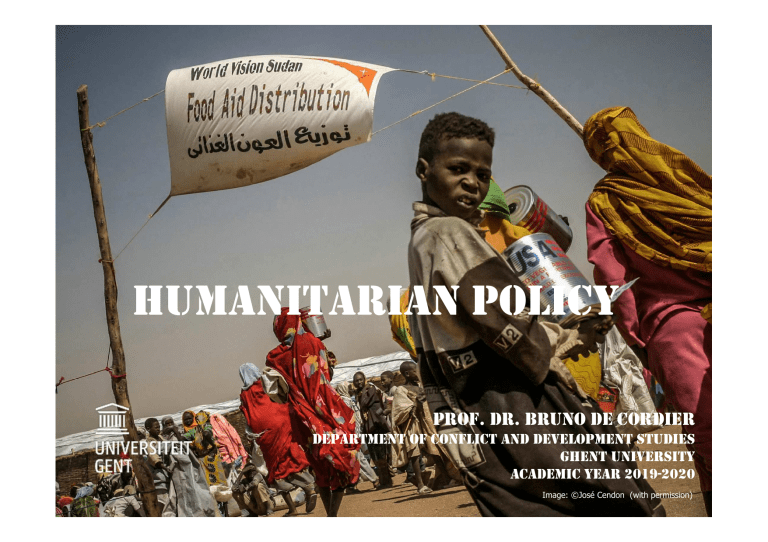
HUMANITARIAN POLICY PROF. DR. BRUNO DE CORDIER DEPARTMENT OF CONFLICT AND DEVELOPMENT STUDIES GHENT UNIVERSITY ACADEMIC YEAR 2019-2020 Image: ©José Cendon (with permission) HUMANITARIAN POLICY HUMANITARIAN AID… WHAT IS IT? • interventions and actions intended to save lives, alleviate suffering and maintain human dignity during and after man-made crises and disasters caused by natural hazards, as well as to prevent further deterioration of conditions, and strengthen preparedness for when such situations occur (= the overall, conventional definition). • raison d’être: emergencies, crises and disasters • the ‘pure types’ of disasters and emergencies: – – – – physical-natural (geophysical, climatological, hydrological, and biological); technological; epidemiological; societal (‘human-caused’) and ‘complex political emergencies’; • in practice: – – – – most are of hybrid nature, causes and consequences; ≠vulnerablity degrees; not all emergencies or disasters become humanitarian crises; ≠ between ‘actual victims’ and the ‘affected population’; ©José Cendon HUMANITARIAN POLICY HUMANITARIAN AID… WHAT IS IT? ©José Cendon HUMANITARIAN POLICY THE RELATIONSHIP TO DEVELOPMENT AID ≠ DEVELOPMENT AID HUMANITARIAN AID AND EMERGENCY RELIEF (A.K.A. ‘DEVELOPMENT COOPERATION’, ‘DEVELOPMENT ASSISTANCE’, ‘TECHNICAL ASSISTANCE’, … ) Yet, major overlaps/‘grey zones’ • project genealogies; • operational contexts; • the relative of the ‘short term’ • hybrid aid organisations; • post-emergency reconstruction; • emergency preparedness and resilience. ©José Cendon HUMANITARIAN POLICY HOW MUCH? 2018: 28.9 billion $ (officially reported) China, India and Bangladesh floods, tropical storms Yugoslav wars and state implosions in Somalia, Liberia, Sierra Leone, … Seaquake and tsunami Haiti earthquake and Pakistan floods Yemen war and Arab intervention Syrian and South Sudanese wars ©José Cendon HUMANITARIAN POLICY WHERE TO? ©José Cendon HUMANITARIAN POLICY HUMANITARIAN AID… WHAT IS IT? • ≠ humanitarian aid and emergency relief emergency relief humanitarian aid • deployed during acute emergency phase (≤72 hours after occurence); • more specific activities; • more prevalent during natural and technological disasters • longer-term (for months, often years after occurence); • more multi-sectoral; • more prevalent during human-caused disasters and complex political emergencies • the notion and practices of humanitarian space • a physically secure space; • a space defined by the application and applicability of 4 fundamental humanitarian principles (‘the ICRC core principles’, °1965): – – – – humanity, neutrality, impartiality, and operational independence ©José Cendon HUMANITAIR BELEID HUMANITARIAN POLICY ©José Cendon HUMANITARIAN POLICY HUMANITARIAN AID… WHAT IS IT? • the notion and practices of humanitarian space • culture and anthropology as key components of the humanitarian space: universalism cultural particularism; • the ‘humanitarian dilemma’: when aid presence feeds the problem … • historical example: North Korean food crisis and floods (1995-99); • current example: Libya and the Central Mediterranean maritime migration (since 2011, cf. map below); Map source, and thematic article: The New York Times, 2017, www.nytimes.com/interactive/2017/06/14/world/europe/migrant-rescue-efforts-deadly.html ©José Cendon HUMANITARIAN POLICY FROM WHOM TO WHOM? ©José Cendon HUMANITARIAN POLICY THE RISE OF IN-DONOR COUNTRY REFUGEE COSTS ©José Cendon HUMANITARIAN POLICY EMERGENCIES AS A RAISON D’ÊTRE ©José Cendon HUMANITARIAN POLICY EMERGENCIES AS A RAISON D’ÊTRE The geography of displacement (2018, in number of individuals) ©José Cendon HUMANITARIAN POLICY EMERGENCIES AS A RAISON D’ÊTRE Internally-displaced by natural disasters ©José Cendon HUMANITARIAN POLICY MAIN ACTORS AND DIMENSIONS ©José Cendon HUMANITARIAN POLICY 1. The donor governments (the ‘DAC Group’ and others) MAIN ACTORS AND DIMENSIONS 2. The specialized UN agencies 3. The International Red Cross Movement THE HUMANITARIAN SECTOR’S EIGHT MAIN ACTORS AND -DIMENSIONS 4. The humanitarian NGOs (international, national and local) 5. International peacekeepers 6. The authorities of/in the recipient countries 7. The private sector (in/of the donor countries, recipient countries as well as iintermediate countries) 8. The beneficiaries, populations and the societies in/of the recipient countries ©José Cendon HUMANITARIAN POLICY FOUNDING CURRENTS AND -TRADITIONS ©José Cendon HUMANITAIR BELEID HUMANITARIAN POLICY ©José Cendon HUMANITAIR BELEID HUMANITARIAN POLICY ©José Cendon HUMANITAIR BELEID HUMANITARIAN POLICY ©José Cendon HUMANITARIAN POLICY 1. The donor governments (the ‘DAC Group’ and others) THE DONOR GOVERNMENTS 2. The specialized UN agencies • the Development Assistance Committee of the Organization for Economic Cooperation and Development (‘the DAC group’, °1962) • • • member countries and institutions: 9 in 1962; 30 since 2016; historically delivers 78 to 95% of official aid globally; DAC regulations: – – – – – • abide by the DAC definition of aid; DAC beneficiary countries list; the ‘86% grant rule’; obligation to report aid flows; abide to defined development goals ‘DAC-ability’ as a universal donorship norm? 3. The International Red Cross Movement 4. The humanitarian NGOs (international, national and local) 5. International peacekeepers 6. The authorities of/in the recipient countries 7. The private sector (in/of the donor countries, recipient countries as well as iintermediate countries) 8. The beneficiaries, populations and the societies in/of the recipient countries ©José Cendon HUMANITAIR BELEID HUMANITARIAN POLICY THE DONOR GOVERNMENTS ©José Cendon HUMANITARIAN POLICY HUMANITAIR BELEID THE DONOR GOVERNMENTS • a closer and concise look at some major governmental donor institutions • United States – US Agency for International Development (USAID, °1961), Bureau for Democracy, Conflict and Humanitarian Assistance • Office for Foreign Disaster Assistance (°1964, all fields except food aid) • Office of Food for Peace (‘title II-V food aid’) – United States Department of Agriculture (‘title I food aid’); – sub-contracting to NGOs, specialized UN agencies, and the ICRC and IFRC (especially the American Red Cross); • European Union – – European Commission Directorate-General for European Civil Protection and Humanitarian Aid Operations (‘DG ECHO’, °2010) sub-contracting to ±200 partner NGOs, UN agencies and ICRC and IFRC ©José Cendon HUMANITARIAN POLICY HUMANITAIR BELEID THE DONOR GOVERNMENTS • a closer and concise look at some major governmental donor institutions • Saudi Arabia • King Salman Humanitarian Aid and Relief Centre (°2015) – – – – replaced the controversial quasi-governmental aid agency al-Igata (IIRO) in an internal centralisation and international image improvement move; under direct control of the ruling family; new donorship drive in the Arab sphere; attempts to join the mainstream international aid industry, has cooperation agreements with various UN agencies and UN relief funds • Muslim World League (°1962) – – – – officially a pan-Islamic NGO, yet…; founded al-Igata (IIRO) in 1978; major organ for pan-Islamic soft power of Saudi Arabia; internationally promoted Wahhabo-Salafism, recently presented and packed in a more ‘moderate’ and ‘presentable‘ form. ©José Cendon HUMANITARIAN POLICY 1. The donor governments (the ‘DAC Group’ and others) THE SPECIALIZED UN AGENCIES 2. The specialized UN agencies • the UN (°1945), a group or ‘institutional family’ – – – – – • 6 core political institutions; 17 specialized agencies; 6 funds and programmes; 8 other entities and bodies; 6 related organisations; the United Nations Relief and Rehabilitation Administration (UNRRA, 1943-47) – – – US-initiated programme under Allied command to war- and occupation-affected Europe (except Germany and German displaced) and China; disbursed 2.9 billion US$ (±75% US-funded) in aid, especially to China, Poland, Yugoslavia, Greece and western USSR, and to fomer war prisoners and concentration camp inmates; worked with ±125 private and faith-based charities 3. The International Red Cross Movement 4. The humanitarian NGOs (international, national and local) 5. International peacekeepers 6. The authorities of/in the recipient countries 7. The private sector (in/of the donor countries, recipient countries as well as iintermediate countries) 8. The beneficiaries, populations and the societies in/of the recipient countries ©José Cendon HUMANITARIAN POLICY THE SPECIALIZED UN AGENCIES Look for the difference(es) ©José Cendon HUMANITAIR BELEID HUMANITARIAN POLICY ©José Cendon HUMANITARIAN POLICY HUMANITAIR BELEID THE SPECIALIZED UN AGENCIES Examples of agencies or offices under the UN Secretariat • • • °1991 (initially a supervision organ for the humanitarian aid of the UN agencies); now coordination department (led by an Under-Secretary-General) of UN and non-UN humanitarian aid; conducts needs mapping, and launches humanitarian funding appeals; has no aid operations of its own, but manages the CERF (°2006, funding 558 million $ in 2018), the CountryBased Pooled Funds (now 17, totaling 817 million US$ ), the Financial Tracking Service (°1992) and the Reliefweb portal (°1996); • had (u. 2015) its own news agency (IRIN Humanitarain News and Analysis, now The New Humanitarian); • based in New York and Geneva • °2004 (replaced UNSECOORD); • UN security department (led by an Under-Secretary-General); general security management and security training for UN and non-US staff; regulates and supervises country-level security policies; • has no aid operations of its own; gained relevance as security situation in many places with humanitarian presence becomes increasingly problematic; • funded on core UN funds; • based in Addis Abeba ©José Cendon HUMANITARIAN POLICY HUMANITAIR BELEID THE SPECIALIZED UN AGENCIES Examples of independent UN agencies • °1950 (initially a 3-year program; replaced the International Refugee Organisation); • provides full-range humanitarian assistance to refugees, IDPs an returnees, and juridical protection ; • 25 à 40% of its aid is delivered through NGOs (±160 international, 470 national and local); • • funded by donor country contributions (3.55 billion $ in 2019, of which US 47%, EC 13%, Germany 5,5%, Sweden 4%, Japan 3,5%, …) and private contributions (±10%); • °1961 (first as a 3-year FAO food aid programme; ind. In 1965); • specialized in food aid, food security rehabilitation and humanitarian logistics; is the largest humanitarian UN agency (and one of the largest aid organisations worldwide); • ± 75% of its aid is delivered through NGOs (±1,000 in 2016, 80% national and local); • manages an own airline (UNHAS); • funded by donor country contributions (8 billion $ in 2019, of which US 41%, FRG 11%, UK and EC 9% each, Saudi Arabia 5%, UAE 3%); • based in Rome based in Geneva ©José Cendon HUMANITARIAN POLICY HUMANITAIR BELEID THE SPECIALIZED UN AGENCIES Examples of independent UN agencies • °1949 (UN General Assembly Resolution №302 (IV)); • is the only region-specific humanitarian UN agency (along with UN Korean Reconstruction Agency, 1950-58); • full-range humanitarian aid and social infrastructure to Palestinian refugees (and their descendents) in Jordan, Lebanon, Gaza and Cis-Jordan, and Syria; • funded by donor country contributions (1.27 billion in 2018, of which EC 14%, Germany 14%, Saudi Arabia 10%, … ); US withdrew funding in 2018; • based in Amman and Gaza ©José Cendon HUMANITARIAN POLICY 1. The donor governments (the ‘DAC Group’ and others) THE INTERNATIONAL RED CROSS MOVEMENT 2. The specialized UN agencies • origins: (group around) Henri Dunant – Geneva, 1863: °Comité international de secours aux blessés durant les guerres (later Comité internationale de la Croix-Rouge); 3. The International Red Cross Movement – Geneva, 1864: °Croix-Rouge internationale; – first national sections in France, Belgium, Prussia and Denmark (1864) (later also outside of Europe: Ottoman empire 1868, Japan 1877, Argentina 1880, US 1881, … ); • the Geneva Conventions on… 4. The humanitarian NGOs (international, national and local) 5. International peacekeepers – 1864: ‘protection of wounded and sick combatants’; – 1906: ‘amelioration of the condition of the wounded and sick in armies in the field’; – 1929: ‘treatment of prisoners of war’; – 1949: ’protection of civilians in times of war’; 6. The authorities of/in the recipient countries 7. The private sector (in/of the donor countries, recipient countries as well as iintermediate countries) – + 2 protocols in 1977 and 1 in 2005; – (!) ≠ Geneva Protocol (1925) and the Geneva Refugee Convention (1951)! 8. The beneficiaries, populations and the societies in/of the recipient countries ©José Cendon HUMANITARIAN POLICY THE INTERNATIONAL RED CROSS MOVEMENT Non-recognized or disused symbols Three levels… 1. The International Comittee of the Red Cross (ICRC-CICR, °1863) The 3 officially-recognized symbols (since June 2006) 2. The International Federation of Red Cross and Red Crescent Societies (IFRC-FICR, °1919 as League of the Red Cross ) … 3. The 192 (2019) recognized national member societies ©José Cendon HUMANITARIAN POLICY 1. The donor governments (the ‘DAC Group’ and others) THE HUMANITARIAN NGOS 2. The specialized UN agencies • first modern humanitarian NGOs (properly speaking): the Save the Children Fund (°1919) and CARE (°1945); • increasing importance and large proliferation of NGOs from 1980-90s (1968: 377 NGOs with ECOSOSC consultative status, 5,161 in 2019); • differ from classical charities, despite no universal definition of a humanitarian NGO: – article 71 in chapter X of the UN Charter (1945): first official mentioning; – UN Economic and Social Council (ECOSOC) resolution №288-B (X) (1950): ‘international NGO = every international organisation not founded by an inter-state treaty’; 3. The International Red Cross Movement 4. The humanitarian NGOs (international, national and local) 5. International peacekeepers 6. The authorities of/in the recipient countries 7. The private sector (in/of the donor countries, recipient countries as well as iintermediate countries) 8. The beneficiaries, populations and the societies in/of the recipient countries ©José Cendon HUMANITARIAN POLICY HUMANITAIR BELEID THE THE HUMANITARIAN HUMANITARIAN NGOS NGOS • differ from classical charities, despite no universal definition of a humanitarian NGO: • in practice, wide range of organisations with common charateristics: – are institutionally not connected to state authorities and governments, are are not staffed or managed by civil servants and government-employees-in-function (yet: the case of ‘government-organized non-governmental organizations’ or GONGOs); – operate non-profit; – are formed on voluntary bases; – operate for (a) common goal(s) and common interests and have modes of operations and run activities to achieve that (these) goal(s); – are organised at the local, national or international level (or all three); ©José Cendon HUMANITARIAN POLICY HUMANITAIR BELEID THE THE HUMANITARIAN HUMANITARIAN NGOS NGOS • NGOs and the ‘aid chain’ • international (globally-operating) NGOs (cross-compared) – ±900 to 2,500 (depending on source and definition) internationally active humanitarian NGOs, yet ±25% of humanitarian expenditure by international NGOs in 2018 came from the ‘big-six’ (MSF, World Vision, International Rescue Committee, Norwegian Refugee Council, Save the Children and Catholic Relief Service); – predominance of so-called ‘confederal NGOs’; – predominance of hybrid NGOs, i.e. conduct humanitarian aid as well and development acitivies (≠ratios); – ≠ amounts of expatriate aid workers; – ≠ funding patterns: e.g. in 2018 MSF (1.69 billion $, 95% privatelyfunded; Norwegian Refugee Council (0.463 billion $, 23% funded by Norway, 17% by European Commission, 20% UN, 5% privately); World Vision (2.75 billion $, ±60% private, 20% in-kind donations, 20% by federal US government; … ); – explicitly faith-based (World Vision) and categorically-secular (MSF); – some have aid activities and volunteer wings in home country; … – emphasis switch to advocacy rather than field aid (e.g. Action Aid) ©José Cendon HUMANITARIAN POLICY HUMANITAIR BELEID THE THE HUMANITARIAN HUMANITARIAN NGOS NGOS • NGOs and the ‘aid chain’ • national and local NGOs – no consolidated number, estimates go in the tens of thousands (extensibility of the definition: only NGOs-as-we-define-them, or also ad hoc ‘one-project structures’, social movements, traditional local charities, farmers’ associations, neighborhood committees, … ?); – main implementers of humanitarian aid at the national and local level, most often as sub-contractors of international NGOs, UN agencies, and larger(er) national NGOs; – ≠ activity patterns: full-range aid and sector-specialized NGOs, nationallyoperating NGOs and NGOs only working in one (or a few) municipality(ies) of district(s), … – an ideal or ‘waterproof’ approach? • varying quality: from dodgy and amateurish to highly professional and well-organised; • largely donor-oriented, or true representatives of the grassroots? • more national NGOs at the beginning of the ‘aid chain’? • an incubator for the regionalisation and de-internationalisation of aid? ©José Cendon HUMANITARIAN POLICY HUMANITAIR BELEID HUMANITARIAN EMPLOYMENT ©José Cendon HUMANITARIAN POLICY 1. The donor governments (the ‘DAC Group’ and others) INTERNATIONAL PEACEKEEPERS 2. The specialized UN agencies • • • by the United Nations, regional organisations (African Union, ECOWAS, …), European Union, ad hoc coalitions, … are (strictly speaking) not a humanitarian actor but highly political operations (implementation of peace agreements, support to a transitional government, border monitoring, … ); 3. The International Red Cross Movement 4. The humanitarian NGOs (international, national and local) however… – most often operate in the same crisis contexts as humanitarian aid workers (cf. map on next slide); – can be deployed to protect humanitarian convoys; – do sometimes conduct relief operations where it is too dangerous for civilian aid workers to do so; – local frustrations about several UN (and other) peacekeeping operations affect position and access of humanitarian UN agencies and civilian aid workers (e.g. MONUSCO in the DRC). 5. International peacekeepers 6. The authorities of/in the recipient countries 7. The private sector (in/of the donor countries, recipient countries as well as iintermediate countries) 8. The beneficiaries, populations and the societies in/of the recipient countries ©José Cendon HUMANITARIAN POLICY HUMANITAIR BELEID INTERNATIONAL PEACEKEEPERS For a higher resolution of this map: www.sipri.org/sites/default/files/2019-05/mpo19_0.pdf ©José Cendon HUMANITARIAN POLICY HUMANITAIR BELEID INTERNATIONAL PEACEKEEPERS ©José Cendon HUMANITARIAN POLICY HUMANITAIR BELEID HUMANITARIAN AID AND THE RECIPIENT ECONOMIES ©José Cendon HUMANITARIAN POLICY 1. The donor governments (the ‘DAC Group’ and others) THE AUTHORITIES OF THE RECIPIENT COUNTRIES 2. The specialized UN agencies • ≠ formal-official authorities and informal authorities ! • formal authorities – the national and sub-national governance institutions of UNrecognized Westphalian states; 3. The International Red Cross Movement 4. The humanitarian NGOs (international, national and local) – attitudes, experiences and practices widely differ; – mainy aid agencies have implementation agreements with national host governments (e.g. =obligatory in the UN): instrumentalisation in local political dynamics? – even with formal authorities, in many cultures informal networks and inter-personal connections matter more than written formal agreements; – in some cases: ‘shove-off’ of civil protection and social policies on foreign aid organisations; 5. International peacekeepers 6. The authorities of/in the recipient countries 7. The private sector (in/of the donor countries, recipient countries as well as iintermediate countries) 8. The beneficiaries, populations and the societies in/of the recipient countries ©José Cendon HUMANITARIAN POLICY HUMANITAIR BELEID THE AUTHORITIES OF THE RECIPIENT COUNTRIES • ≠ formal-official authorities and informal authorities ! • formal authorities – increasing conditionality-and-moralisation wearyness: re-orientation to non-DAC donors? – in number of recipient countries (India, Pakistan, Ethiopia, … ): growing restrictions on foreign(-funded) NGOs; – (often long and intensive) experience of recipient governments with international aid: incubator for own donorship policies and de-internationalised humanitarian aid? • informal authorities – wide range of actors: traditional authorities and -actors, religious authorities and -actors, clanic and regionalist networks, authorities and actors in the informal economy, gangs, … – are locally and in daily practice often more important than the formal state authorities; – norms and values differ starkly from those of (or advocated by) the international aid sector; – what with non-recognised states (e.g. Somaliland) and areas under nongovernmental governance (e.g. Donbass in southeastern Ukraine)? ©José Cendon HUMANITARIAN POLICY 1. The donor governments (the ‘DAC Group’ and others) THE PRIVATE SECTOR 2. The specialized UN agencies • • involves transnational corporations as well as (local) small and medium enterprises; how? – – the humanitarian sector as a customer of both the transnationalcorporate and the local private sector; • purchase of aid goods, equipment and services; • the ‘consultant ecology’; • the case for local and triangular purchases of food aid; the private sector as donor and initiator of humanitarian initiatives • active role of local entrepreneur(s) (networks) in immediate relief; • (contested) donations from corporate philanthropists 3. The International Red Cross Movement 4. The humanitarian NGOs (international, national and local) 5. International peacekeepers 6. The authorities of/in the recipient countries 7. The private sector (in/of the donor countries, recipient countries as well as iintermediate countries) 8. The beneficiaries, populations and the societies in/of the recipient countries ©José Cendon HUMANITARIAN POLICY 1. The donor governments (the ‘DAC Group’ and others) THE BENEFICIARY POPULATIONS AND RECIPIENT SOCIETIES 2. The specialized UN agencies • a real ‘last, but not least’… • = by far one of the most under- or misestimated actors in the humanitarian sphere; • worlwide population reportedly in need of some form and quantity of humanitarian assistance in 2018: 201.5 million; • the role of international media coverage and humanitarian PR and –fundraising materials (but also certain local actors… ) in the popular and persistent cliché of helpless amorphous mass at the receiving end; 5. International peacekeepers consist, and belong to, active and complex societies which… 6. The authorities of/in the recipient countries - • – traditionally have their own mechanisms to deal with (recurrent) disaster and crisis situations; – are not wholesale poor and destitute; 3. The International Red Cross Movement 4. The humanitarian NGOs (international, national and local) 7. The private sector (in/of the donor countries, recipient countries as well as iintermediate countries) 8. The beneficiaries, populations and the societies in/of the recipient countries ©José Cendon HUMANITARIAN POLICY HUMANITAIR BELEID THE BENEFICIARY POPULATIONS AND RECIPIENT SOCIETIES • consist, and belong to, active and complex societies which… – are not dumb and naïve (cf. have ways to actively capitalise on foreign presence, ‘aid wearyness’, strong consciousness of political and cultural reformating designs behind foreign aid, … ); – have own, active practices of charity and social solidarity by the ‘veritable civil society’ (or’ civil-society-as-it-is’)… • • • • • – • religious institutions and -networks; political clientelist networks; diasporas and financial remittances; youth wings of political movements; professional associations, guilds, …; parallel systems of self-goverance and informal economies in refugee- and IDP camps and –settlements; some symptoms and impacts of ‘aid indigestion’ (at least among some sectors of society) – – – – ‘aid profiteering’ and cynicism (including exaggerating needs); wrong or inflated expectations and entitlement cultures; price speculation and salary inflation; growing social and cultural hostility among the grassroots and local authorities vis-à-vis local employees (‘aid elites’) of international aid organisations and sub-contracted local NGOs. ©José Cendon HUMANITARIAN POLICY HUMANITAIR BELEID READING LIST ON HUMANTARIAN AID Standard works and handbooks Journals and reviews • Clapp, Jennifer (2012), ‘Hunger in the balance. The new politics of international food aid’, Cornell University Press. • Disasters ̶ The Journal of Disaster Studies, Policy and Management, www.odi.org/projects/2952disasters; • Dijkzeul, Dennis en Herman, Joost (2010), Humanitaire ruimte: tussen onpartijdigheid en politiek’, Academia Press. • Alternatives humanitaires-Humanitarian alternatives , alternatives-humanitaires.org/fr/ (available in French and English); • Lieser, Jürgen, Dijkzeul, Dennis (2013), ‘Handbuch humanitäre Hilfe’, Springer Verlag. • Mac Ginthy, Roger, Peterson, Jenny H. (2013) ‘The Routledge companion on humanitarian action’, Routledge. • Ryfman, Philippe (2016), ‘Une histoire de l’humanitaire’, La Découverte. • Tarp, Finn (2002), ‘Foreign aid and development. Lessons learnt and directions for the future’, Taylor and Francis. • Allen, Tim, McDonald, Anna, Radice, Henry (eds.) (2018), 'Humanitarianism: a dictionary of concepts', Routledge. • The European Journal of Development Research, www.palgrave.com/gp/journal/41287 ; • Humanitarian Exchange, the Working & Discussion Papers, the Briefing Papers and the Research Reports of the Humanitarian Policy Group of the Overseas Development Institute, www.odi.org/publications ; • Humanitaires en movement- Humanitarian aid on the move, by the Groupe Urgence, Réhabilitation et Développement, www.urd.org/en/publication/ (available in French and English); • Forced Migration Review, www.fmreview.org/ (materials available in four languages).; • Revue internationale de la Croix-RougeInternational Review of the Red Cross, international-review.icrc.org/fr (materials available in five languages). ©José Cendon
